#ingneous
Explore tagged Tumblr posts
Text
Ingneous more like INGENIOUS AMI CORRECT ?????
11 notes
·
View notes
Photo


Sailing across the desert...
Glancing through our database I realised with a shock that we had never covered one of New Mexico's most iconic geological monuments, the volcanic remnant known as Ship Rock. I shared an aerial photo to reveal the surrounding geology, and a side one showing its graceful lines. Seeming to float above the heat haze, it records the explosive eruption some 27 million years back of an unusual kind of water rich volcanic rock that rose from the mantle called a lamprophyre (kimberlite and lamproite, magmas that carry diamonds up from the mantle are a part of this complex family).
The main hill, known in the Navajo tongue as Tse Bitai (winged rock) is 482 metres high, and 500 in diameter, providing a powerful contrast to the surrounding flat landscape, evidencing the fact that the volcanic rock is more resistant to erosion than the surrounding sedimentary sandstone and shale. Known as a volcanic neck, it is the remnant of a carrot shaped pipe that spat lava out of the mantle at speed, fracturing itself on the way up to form a breccia (a broken up rock with angular fragments or clasts, in this case autogenerated as the pressure released on the way up).
The lamprophyre clan is very complex, with many hazy and different lines drawn between its members, it may be that each eruption is unique, recording the heterogeneous mantle conditions in which the small degree of partial melting that produced the magma occurred. Ship Rock is made of a potassium rich member, known as minette. Erosion has removed the surface expression of the eruption, and the part of the pipe visible now is thought to have been around a kilometre down when the volcanic plumbing system froze.
Surrounding the ship are a half a dozen dark dykes, sheets of magma that were part of the eruption, possible the feeder system or the lava penetrating through surrounding weak points fractured by the explosive force. These dykes are the more usual expression of lamprophyres, and while no one knows where the connection lies, their presence as swarms are often associated with regional gold mineralisation. The rock is part of a volcanic field extending through the area that include El Capitan in Monument Valley.
The monument is sacred to the Navajo Nation and sits on their lands near the four corners region of the southwest, in the centre of the region occupied by the Pueblo People. The Navajo name comes from the legend of the great bird that bought their people southwards, and it is supposedly the first place in which they dwelt in their new home region. Legend states that many of the people were cut off on top when lightning destroyed the path, died there, and haunt it to this day (a not impossible proposition, recent research shows that lightning can help shape entire mountain ranges, seehttp://on.fb.me/1AQ1Chv). For this reason climbing it is forbidden. The English one comes from its obvious resemblance to a sailing vessel.
I studied one of these weird rocks as one of the samples for my thesis, and in the scope they appear amazing, with all sorts of chewed up crystals partly transformed into something else. As they rise and the pressure releases, the water comes out and starts to transform the mantle minerals such as olivine into surface ones such as micas (giving them their glinty surface appearance). In short, the rock sort of reverse autometamorphoses on the way up, as the usual metamorphic influence of growing deep crustal heat and pressure is inverted at speed. When these changes happen more slowly, the transformation is minimal, as many mantle minerals are metastable in surface conditions, ie they last for awhile before they chemically weather into something else.
Loz
Image credit: aerial photo Weather Underground, side snap Bowie Snodgrass http://lapahie.com/shiprock_peak.cfm https://geoinfo.nmt.edu/tour/landmarks/shiprock/home.html http://pubs.usgs.gov/gip/volc/structures.html
226 notes
·
View notes
Text
I’m back from my rock show! Who wants to see all my new Cool Rocks?

This little guy is red corundum, also known as a ruby! It naturally grows in that hexagonal shape. Here’s a fun rock fact: if this corundum was any other color, it would be called a sapphire!

I’ve gotta get some sunlight shining on this one. It’s the only way to properly appreciate rutilated quartz! This super clear quartz has a whole forest of golden needles of rutile growing inside! The only bad thing about rutilated quartz is that photos don’t do justice to how sparkly and golden and amazing it really is.

This is half of what’s called a pyrite sun! Pyrite’s known for its cube-shaped crystals, but did you know it can form in flat round disks like this too? They’re also called sun dollars, and pretty much the only place in the world where they occur is my home state of Illinois!
I won this rock at the show’s silent auction, and somebody else went home with the other half of the disk. It’s cool to think that somewhere out there, someone has the other half of my rock.

Here’s some more pyrite! These pyrite crystals didn’t form in the usual cube shape either. They’re slightly rarer dodecahedral crystals! Those pointy white crystals growing around them are a mixture of calcite and dolomite. The other cool thing about this specimen is the beautiful bronzy reddish color of the pyrite, which was probably caused by oxidation, the pyrite chemically reacting with oxygen.

Opal! Opal opal opal!! It’s about the same size and color as a piece of chocolate, which is fitting because this is Ethiopian chocolate opal!

The play of color is amazing against that dark background. Here are some more pictures of all the different colors in this opal. I’m particularly blown away by that blue!
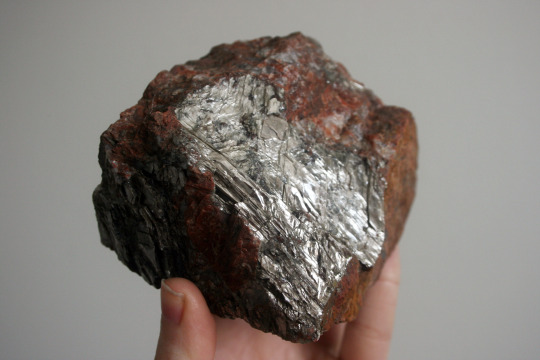
This is pegmatite, an ingneous rock. Igneous rocks are the rocks that form when molten lava cools and hardens, and pegmatites are igneous rocks which form with abnormally big crystals. Usually crystal growth happens really slowly, but the crystals in pegmatite are able to get really big because they form really fast! I didn’t wrap this rock in tinfoil. The huge shiny patch on this pegmatite is probably either molybdenite or graphite - the stuff in pencil lead!
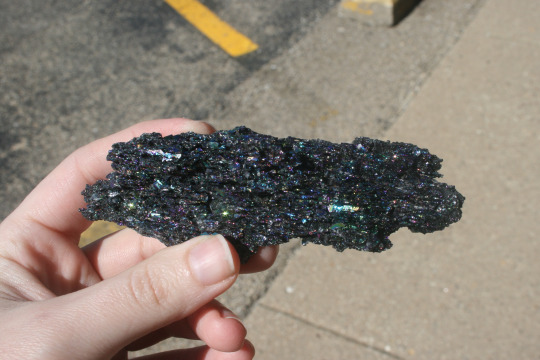
How about a manmade rock? This is silicon carbide, also known as carborundum! It’s created by heating carbon and silica and is used for all kinds of things - like an abrasive for saws and cutting tools. I own a dremel with some silicon carbide bits! Of course it also makes for an amazing iridescent gemstone.
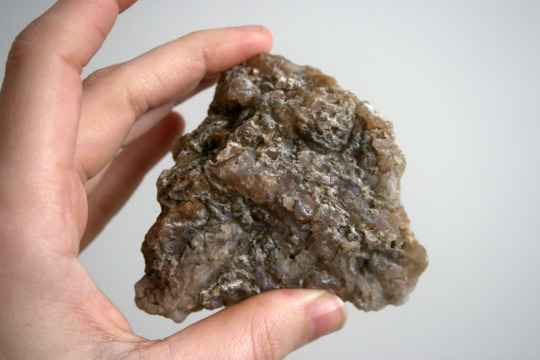
This weird looking rock is chalcedony! And it’s cool because it’s very slightly sort of technically radioactive!!! My little rock viewing light isn’t powerful enough for this kind of fluorescence, but if I had the right kind of UV light, I could show off how this guy fluoresces neon green! Green fluorescence in chalcedony is caused by uranyl ions… as in uranium!
Don’t worry, this rock isn’t radioactive enough to hurt me. Lots of quartz, jasper, and chalcedony contain tiny amounts of uranyl ions, but uranium’s actually pretty safe stuff! Even solid chunks of uranium ore are safe enough to hold in your bare hands. I got to handle some at the rock show!
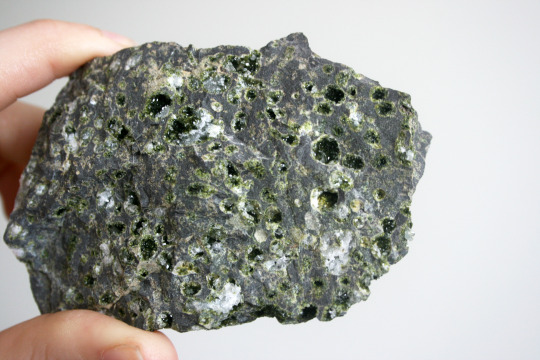
This rock is full of tiny, hollow pockets lined with green crystals of epidote. Epidote has some Cool Optical Properties, but these crystals are much too small to show them off. Supposedly, large crystals of epidote change color depending on the angle you view them! But this rock has sparkly green spots, and that’s enough to file it under Rocks That Make Me Happy!

Speaking of green rocks, this is pyromorphite! I’d never even heard of this rock before going to the rock show, but it’s my favorite color, so this is my new favorite rock! Here’s all the Cool Science I’ve been learning about it.
This specimen came from Daoping Mine in China, which produces some really large, beautiful crystals of this stuff! Pyromorphite is a type of apatite, so it’s like the sister of the blue and yellow apatite specimens I already own. It’s a lead ore, so if I ate it, I’d be super dead! Pyromorphite can actually form in the soil of industrial areas which are polluted with large amounts of lead. Some scientific studies have been done about maybe using that transformation of lead into pyromorphite as a way of cleaning up polluted soil by making the lead safer and less water soluble. But it turns out that’s not a good solution, because there’s a species of fungus that likes to turn pyromorphite back into lead! That fungus is black mold, the same stuff that makes you super sick if it starts growing in your house. Geeze black mold, why are you so terrible in literally every context?
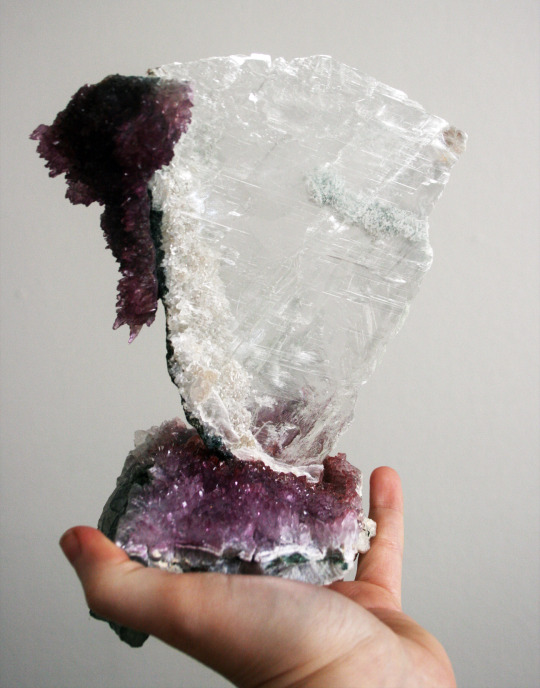
Big sparkly girl! Big sparkly girl!! This is probably the second best rock I came home with. It’s a big plate of selenite with a bunch of interesting inclusions. (And I cannot resist interesting inclusions.) It didn’t grow out of that piece of quartz; that’s actually its display stand! This Cool Rock is a conglomerate of several different rocks held together by resin - it’s an art piece! The quartz has been dyed purple to made the colorless selenite really stand out against it. If you don’t like manmade rocks, cool displays like this are probably not for you, but I think it’s a neat way of showing off a rock! Sort of like a little rock statue for my apartment.
But now for the best rock…
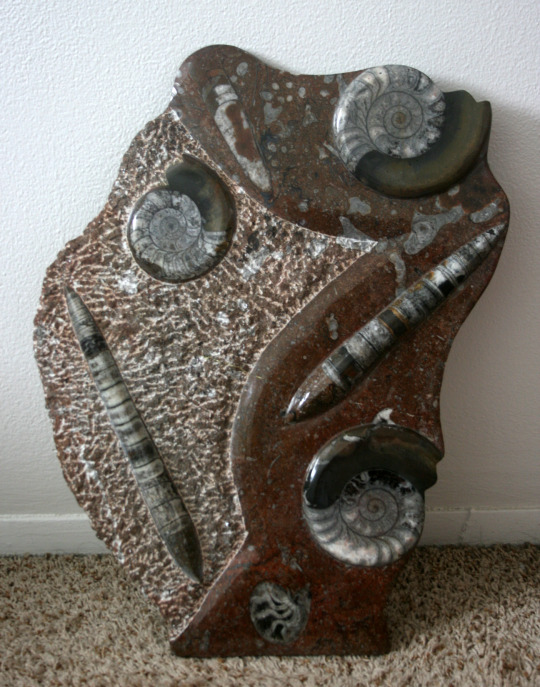
Big fossil boy! Massive fossil boy!! Absolutely enormous fossil boy!!!

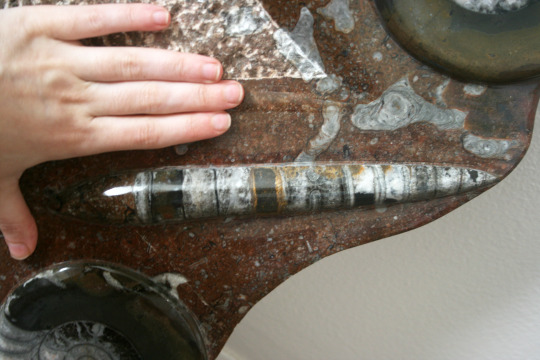
Here is my unreasonably large pianist’s hand for scale. These fossils are huge! Those long cones are the skeletons of orthoconic nautiloids, but you might have also heard of them as orthoceras. They were big cone-shaped cephalopods! They’re found all over the world and actually belong to a whole bunch of different species, though scientists didn’t realize that for a long time and just called them all orthoceras. I’m not sure if the spiral fossils are nautiloids or ammonoids. You’re supposed to be able to tell from the shape of the shell. Nautiloids, maybe?
What a cool find! Nothing is better than coming home from a rock show with a bunch of new rocks! There’s only one problem now.
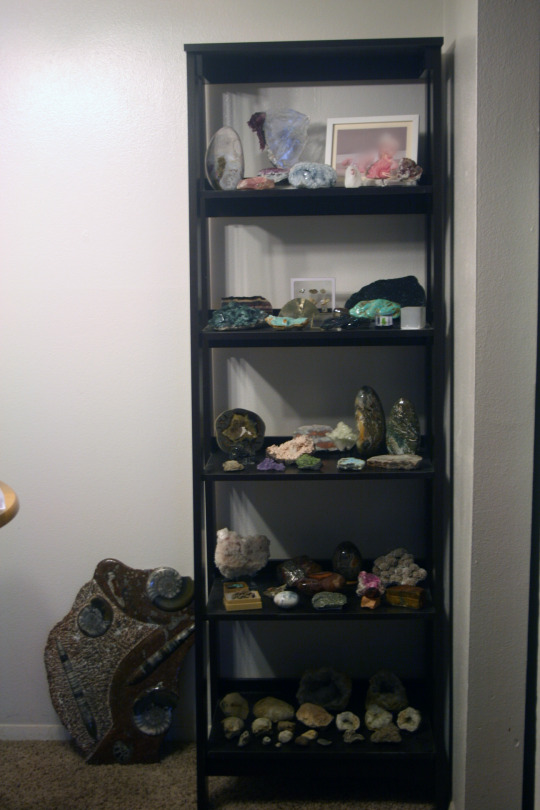
I’m gonna need another bookshelf.
2K notes
·
View notes